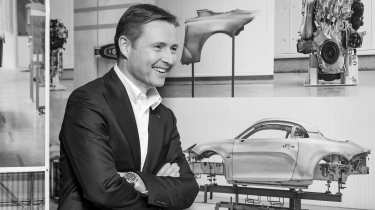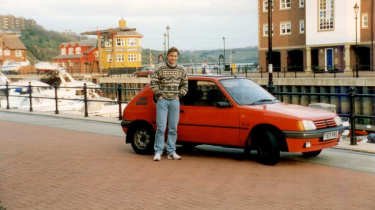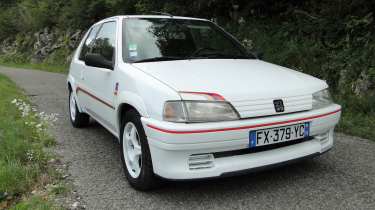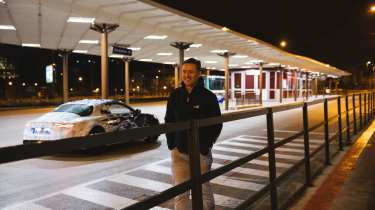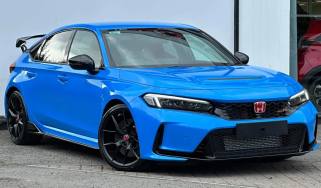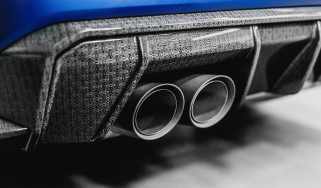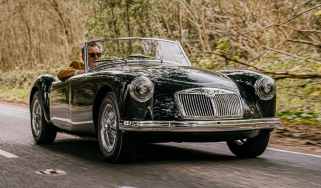My Life & Cars – David Twohig, automotive engineer
The Alpine A110’s lead engineer talks about the wide-ranging projects he’s been instrumental on and the cars he’s chosen for himself
Becoming a chief vehicle engineer and being responsible for a whole car is a position that only a handful of automotive engineers get to enjoy. To lead a team and deliver a car that also hits or exceeds the brief is therefore a great achievement. To do that three times and then, after delivering each one, go off to do something completely different suggests a restless and healthy curiosity.
That hunger for new challenges has certainly served David Twohig well in the course of his career to date. Three of the major projects he’s led have been diverse and, in their own ways, successful: a small crossover that saved a company, a big-selling EV hatchback before EVs became popular, and a sensational lightweight sports car from a firm that was reluctant to see said car through to production.
> My Life & Cars – Matt Becker, vehicle dynamics wizard
We meet Twohig at ItalDesign in late May, doing what he does these days: offering his engineering insight and guidance. Usually it’s behind the scenes and a water-tight NDA, but this project is different. We’re in Turin to see the full-size clay of the all-new Caterham Project V and Twohig has been brought in by Bob Laishley, Caterham’s CEO, to offer an expert eye on the project. Laishley and Twohig go back a long way having worked together at Nissan, and Laishley is keen for the benefit of Twohig’s broad experience.
For Twohig, born and brought up in Cork, in the south of Ireland, Nissan was his first home as an engineer. Did he always think he’d go into engineering? ‘Yeah, I was one of those horribly predictable kids,’ he says. ‘My dad was a car nut, my older brother was a car nut, my earliest memories are passing spanners to my dad who was fixing some crappy old Ford. My dad was a frustrated engineer. His generation never got a chance to go to college, so I guess he was living that vicariously through me. Being an engineer is all I’ve wanted to do… apart from a brief spell of wanting to be Tom Cruise in Top Gun when I was 16.’
He learned to drive in his dad’s Sunderland-built Nissan Bluebird and passed his test aged 17 before going to university in Ireland in the early ’80s. ‘I was kind of lucky,’ he says, with typical self-deprecation. ‘I’d figured out that electronics, which was already starting to be a big thing, would be the future in some way. It was the only smart thing I ever did, figuring out that I’d have a better chance to stand out if I was a sparky, and it kind of paid off because I landed my dream job.’
That job was with Nissan at their engineering centre at Cranfield, Bedfordshire. The year was 1992 and Nissan was trying to expand its market share in Europe. They’d built their plant in Sunderland and ran with the slogan ‘Cars designed by Europeans, built by Europeans, for Europeans’, which really appealed to Twohig. ‘My first project was designing brackets for ABS brake sensors. Little by little you work your way up. Maybe you’ll be given a component, then they’ll give you a section of a car, and then you might get a modification to a car, and if you do OK, keep your nose clean and don’t screw up too badly, you might get a whole car.’
With his first pay packet he was able to buy his first car. ‘It was a Peugeot 205 XS; I couldn’t afford a GTI. I found a pretty leggy XS and I loved it to bits. I’m still a sucker for those things…’ At Nissan he did more than keep his nose clean, because just ten years after starting, aged 32, he found himself in the role of chief engineer for the first Qashqai. It was a make-or-break car for Nissan in Europe, the previous two having been financial disasters, and it was also the first car engineered outside Japan for Europe.
‘This was a big chance. I got sent to Japan for a year to basically learn how to do a car. I wasn’t by myself; 30 of us were stupid enough to raise our hands. We did the first year in Japan because this was a global platform but also because you go to Japan to pick the bits you want. The rest of the development was done in Europe. We were off the leash.’
Twohig is quick to credit the advanced product planning department in Japan, specifically Patrick Pélata, for the concept. ‘He said, “You know the Nissan Murano?” and of course I knew the Murano; it was a big, big hit in the US. He said, “Make me a photocopy of the Murano, 80 per cent scale.” That was it. A lot of people think that it was super-intelligent market research. No. It was simply let’s do an 80 per cent Murano for Europe.
‘Did we know we had a hit on our hands? Absolutely not. We thought we were doing a good job but we really didn’t know that the market was right for it. Japan’s sales estimates were bold: 135,000 in its peak year, double the Honda HRV. The first year it did 250,000. Second 270, third 270 and basically it flatlined at 270 for five years. It got nicknamed the Cashcow because it was essentially a money-printing machine.’
Twohig loved Japan and the obvious next step would be to move up the Nissan corporate ladder. Instead, he transferred to ‘the dark side’ and went to Renault. ‘The Renault-Nissan alliance in 2006 was a big deal. I was Golden Boy at Nissan with this kind of undeserved rookie success… and I went to Renault where they couldn’t pronounce my name.’ Not only that, it was a demotion. ‘So Renault took this guy who didn’t speak French, didn’t know much about powertrains or packaging and made him the head of powertrain packaging. What could possibly go wrong?
> Alpine A290 GTS 2025 review – is the Renault 5 relative a true hot hatch?
‘I did that for a few years and it was fantastic. It was kind of back to the drawing board, relearn your trade. Then in about 2008, I started work on a little, front-wheel-drive, all-electric car that was to become the Renault Zoe. I made myself a complete pain in the ass telling all the big bosses I wanted to do this car. To shut me up they said, “OK, do the bloody car.” I was fascinated by it. Like the Qashqai it was very high profile, very high risk, but I wasn’t afraid of the risk. People look at it now and it’s just a boring electric shopping car, but it was an absolutely fascinating project because the technology didn’t exist back in 2008 – it needed to be invented.’
Independently, Nissan was working on the Leaf, which was about a year ahead. ‘There is almost zero commonality between the two cars,’ says Twohig. ‘I think I made a wisecrack that there are two common parts – a water pump and a bracket – so from an external point of view it’s a good example of two companies failing to work together. However, the chief engineer on the Leaf, Kadota‑san, and I would talk on the phone every Friday. He was basically mentoring me: “Whatever you do, don’t do this!” Zoe was a bit of a slow-burner in the first few years but picked up, and until two years ago, when it was overtaken by the Tesla 3, it was the best-selling EV in Europe.
‘I got some fancy promotion, I was vice-president of an engineering division, and then I got wind of this bloody Alpine A110,’ he says. ‘So I put my hat in the ring again, badgered the right people and found myself heading up the A110. So, once again, I took a demotion. But I couldn’t miss that one.’
The project kicked off in 2012, in secret, a joint venture with Caterham, which at that point was under the control of entrepreneur Tony Fernandes. ‘It was going great guns until it wasn’t,’ says Twohig, ‘and that was when it turned out Fernandes didn’t have as much money as we’d thought.’ That put the project in a bit of trouble because not only was Caterham providing half the money, it was also providing half the engineering team.
This was 2014, when Twohig took it on. ‘It was a case of let’s finish this because the fundamentals are excellent,’ he says. ‘I give a massive tip of the hat to Caterham, and when I do that I’m automatically giving it to Lotus. I said to the French journalists at the launch that 50 per cent of it’s British, and they hated me for it but it was true. The fundamentals were really good so we didn’t need to start again, but now we had all the financial risk. Carlos Tavares, who was then Number Two at Renault, was instrumental in persuading [CEO Carlos] Ghosn we should do it.
‘So I worked in this site with 11,000 Renault engineers. Imagine how many petrolheads are there, how many frustrated engineers working on the fourth generation of a brake caliper for a Clio. For a while, it took me 20 minutes to go and grab a coffee because every guy would walk up and say, ‘Here’s my CV.’ It did mean that Twohig had the pick of the engineers, yet even though Renault management had decided to go ahead, it was conflicted by its own decision.
‘We almost died every month,’ says Twohig. ‘Almost every month, Alpine CEO Bernard Ollivier and I would have to report to the executive committee and every time it was touch and go. The company was terrified by the project, wasn’t confident we could pull it off. There was this lack of self-belief among top executives, a feeling it’s got to be competing with Porsche, even though we explained until we were blue in the face that it would be different.
‘In 2017 we did the static presentation [at the Geneva motor show] and the reaction was unbelievable. It was huge. I was very honoured I got to do the launch; you know, be the guy with the microphone. I remember Ferrari was on the stand next to us and as we started to do our press conference there were people climbing on top of the Ferraris – photographers! So we knew we had something. And then we did the dynamic launch in the south of France and the first press reports came out, and there was a consensus that we had something. I’ll be honest with you, internally in the company, the feeling of “we told you so”… It was very nice walking the corridors for the next few months. Very satisfying.’
True to form, Twohig’s next career move was not the obvious one. ‘I should have gone back into the parent company, been a good corporate soldier, but I couldn’t face it. I’d run this small team for four years and I didn’t realise it but it was effectively a start-up. I just wasn’t up for heading up big teams any more.’ So soon after he found himself in California working for Byton, an EV start-up. There would be no fairytale ending to this one, though. ‘I was intrigued by the start-up culture in California. I was 48. If I didn’t do it then… It was fantastic – while it lasted. We committed the cardinal sin of start-ups: we ran out of money. The burn rate was enormous and we failed to keep the cash coming in to match the cash going out.
‘When Byton hit the buffers I was swept up by a company called Waymo, which is better known as Google’s self-driving car. I genuinely can’t say what I was working on.’ He enjoyed his time in California and learned lots but came back to Europe to be closer to increasingly frail parents in Ireland. He’s now settled near Annecy, in southern France, which he loves, even though it means taking a lot of flights for his engineering consultancy role.
There isn’t an A110 in the garage but there is an early 911, a 3.0 SC, which Twohig argues is much the same thing; it has been thrifted down to about 1000kg. He’s currently looking for a Yamaha R1 to replace the one he sold before going to California, and he recently purchased a car with echoes of that 205 XS: a Peugeot 106 Rallye. ‘It’s more hardcore than the XS. It’s stripped to the bone, you know. My wife hates the thing but every time I drive it I feel like an 18-year-old again.’
This story was first featured in evo issue 312.

